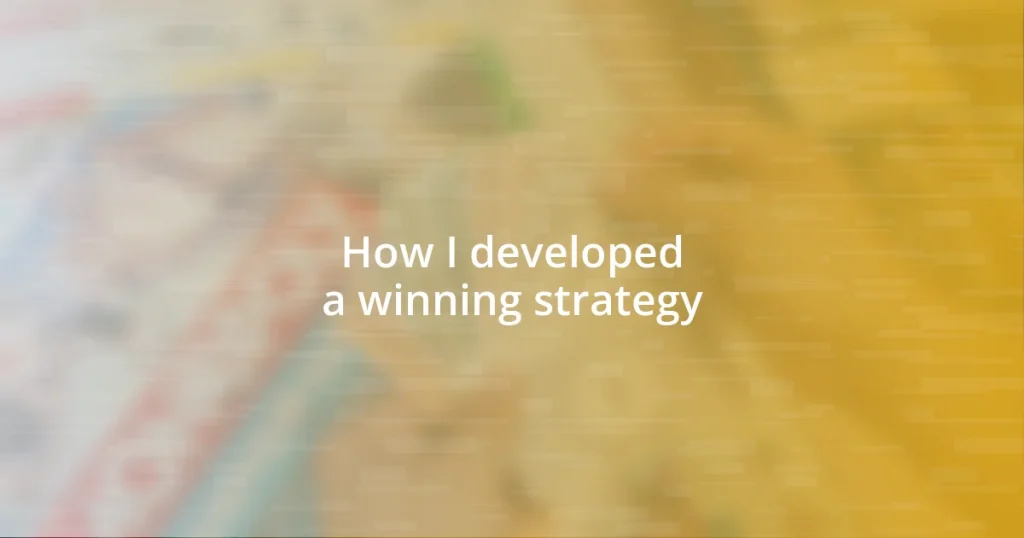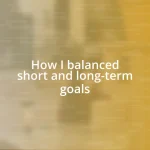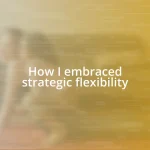Key takeaways:
- Understanding personal strengths and challenges is crucial for crafting effective winning strategies, emphasizing self-awareness and adaptability.
- Setting specific, measurable, and realistic goals fosters motivation and aligns personal aspirations with professional objectives for greater engagement.
- Continuous learning and embracing setbacks as growth opportunities enhance strategy development, leading to innovative solutions and team resilience.

Understanding Winning Strategies
Winning strategies come from a deep understanding of both your strengths and the challenges ahead. I remember a time when I was faced with a daunting project at work. Instead of feeling overwhelmed, I took a step back, assessed my skills, and formulated a plan that played to my advantages. Isn’t it interesting how knowing yourself can be the cornerstone of success?
I often find that the most effective strategies aren’t born from impulsive decisions but from thoughtful reflection on past experiences. For instance, during a competitive analysis for a new product launch, I discovered that listening to customer feedback can reveal crucial insights. Have you ever noticed how consumers often hint at what they truly want? It’s this kind of direct engagement that not only shapes a winning approach but also fosters trust and loyalty.
Ultimately, crafting a winning strategy is like navigating a complex maze—it’s about being adaptable and open to change. There was a moment in my career where my initial idea fell flat. I had to pivot quickly, incorporating lessons learned along the way. This flexibility taught me that a successful strategy is more than a plan; it’s a living, breathing entity that evolves with each step we take.

Identifying Key Goals
Identifying key goals is essential for ensuring your strategy is focused and effective. I remember when I was gearing up for a major sales campaign, and the first thing I did was sit down and determine what success truly looked like for me. I broke it down into specific, measurable objectives rather than vague aspirations. This clarity is what propelled my efforts; without well-defined goals, it’s easy to wander off track. Have you ever noticed how much easier it is to stay motivated when you know what you’re striving for?
It’s not just about the outcome but also about the journey towards achieving these goals. I once found myself setting targets that were ambitious but not entirely feasible, leading to frustration. By taking a more realistic approach, where I scaled my objectives to match my resources and timelines, I was able to maintain my motivation and celebrate smaller victories. This adjustment taught me that setting achievable milestones can foster a sense of accomplishment that fuels further progress.
When I think about the alignment between my goals and overall strategy, it becomes evident that there’s a direct link to engagement and commitment. Since shifting my focus towards aligning personal aspirations with professional objectives, I’ve experienced greater satisfaction in my work. Recognizing what really drives me helps create a powerful synergy that not only boosts my results but also enriches my professional life.
| Goals | Description |
|---|---|
| Specific | Clear and detailed goals that outline exactly what you want to achieve. |
| Measurable | Goals that can be tracked and assessed to determine progress. |
| Realistic | Setting attainable goals that align with available resources and time. |
| Aligned | Ensuring goals support each other and contribute to a larger vision. |

Analyzing Market Conditions
Analyzing market conditions is a critical step in developing a winning strategy. During a product launch I managed, I remember being deeply immersed in understanding consumer behavior through exhaustive research. By observing trends and patterns within the data, I could identify opportunities that others overlooked. It’s fascinating how the nuances of market dynamics can often guide us toward innovative solutions.
Here are some key factors I focused on when analyzing market conditions:
- Market Trends: Tracking industry trends helps gauge the competitive landscape.
- Consumer Preferences: Understanding what drives customer choices enables tailored strategies.
- Economic Indicators: Monitoring indicators like inflation and employment rates provides context for market health.
- Competitive Analysis: Assessing what competitors are doing can reveal gaps and potential advantages.
- Regulatory Factors: Staying informed about regulations can prevent costly missteps.
This firsthand experience taught me that thorough analysis goes beyond just collecting data; it’s about weaving those insights into a narrative that drives decision-making. I felt an exhilarating sense of clarity once I connected the dots between market data and our strategic choices. It’s like having a map that not only shows the terrain but also highlights the best paths to achieve success.

Developing Actionable Plans
Developing actionable plans is where the rubber meets the road in strategy creation. I vividly recall a time when my ambitious goals felt overwhelming, almost paralyzing. It was during a product rollout that I realized I needed a clear roadmap to navigate. I started with small, digestible steps that led me toward my larger objectives. Each milestone became a mini-celebration, reinforcing my commitment to the overall vision. Have you ever tackled a daunting project by breaking it into manageable bites? It makes the journey not just feasible but enjoyable.
In my experience, sticking to a structured timeline played a crucial role in holding myself accountable. I often set aside time each week to assess progress and adjust my plans accordingly. This reflection period often brought me unexpected insights—sometimes, the best ideas emerge during quiet moments of reassessment. I can’t stress enough how vital it is to remain flexible and open to change while still keeping your sights on your ultimate goals. How do you stay adaptable when facing unexpected challenges?
Finally, I encourage you to maintain a clear communication channel with your team throughout the planning process. When I worked on a collaborative project, I found that regular check-ins allowed everyone to voice concerns and share ideas, which enriched our plans. There’s something powerful about collective input that can shine a light on blind spots in individual thinking. Do you believe collaboration enhances strategic planning? I know from my own successes that it builds a sense of ownership among team members, and that often translates into better execution.

Implementing Effective Techniques
Implementing effective techniques in strategy execution is like fine-tuning a musical instrument; every adjustment matters. I once led a marketing campaign where we rolled out a series of A/B tests to identify the most engaging messaging. It was exhilarating to see how slight changes in wording could significantly uplift our engagement rates. Have you ever noticed how a simple tweak can make a world of difference in communication? This experience highlighted the power of experimentation and responsiveness in achieving our goals.
One technique I found invaluable was the practice of reflective debriefing after every campaign phase. I vividly remember a team meeting where we dissected our last initiative, and it struck me just how much valuable insight emerged from our candid discussions. It was almost like opening a treasure chest of knowledge we didn’t realize we had! Reflecting collectively on successes and failures fosters a culture of learning that can be transformative. Have you ever participated in a discussion that clarified your next steps in an unexpected way?
Moreover, I can’t emphasize enough the importance of data-driven decision-making. I had a moment during a product launch where I initially relied on instinct alone and then later realized that backing my decisions with solid data shifted everything into focus. It was as if flipping a switch that illuminated the path ahead. The analytics revealed opportunities I had never considered. Do you ever find yourself surprised by what the data reveals? I learned that embracing data not only strengthens strategy but also builds confidence in your execution.

Measuring Success and Adapting
Measuring success isn’t just about celebrating wins; it’s about developing a keen sense of what those wins signify for our broader objectives. I remember a pivotal moment when I tracked a project’s key performance indicators (KPIs) and discovered an unexpected dip in engagement. At first, it felt disheartening, but I quickly realized it was an opportunity to pivot. Isn’t it fascinating how numbers can guide us toward deeper insights? Embracing those data points transformed what could have been a set-back into a launching pad for improvements.
As I adapted my approach based on those revelations, I learned the importance of continuous measurement. During one initiative, I implemented weekly check-ins focused on both outputs and outcomes, fostering an agile mindset in the team. I noticed how this constant evaluation empowered everyone to take ownership of our collective progress. Have you ever felt the rush of being part of a team that dynamically shifts course based on real-time feedback? It’s invigorating!
Ultimately, the journey of refining strategies requires a blend of hard data and intuition. I often found myself trusting my gut when the numbers felt off, leading to shifts that proved to be game-changers. For instance, a marketing tactic that seemed successful on the surface was losing traction, and listening to my team’s instincts led us to reevaluate our messaging approach. Have you experienced moments where intuition guided strategic changes? That blend of analytical rigor and intuitive insight can be a powerful catalyst for success.

Continuous Improvement and Learning
Continuous improvement and learning have become essential cornerstones of my strategy development process. I remember attending a workshop on agile methodologies that challenged my perception of how projects should unfold. The trainers emphasized the value of ongoing feedback loops, and I was inspired to integrate that mindset into my own work. Have you ever experienced a shift in perspective that changed how you approached a familiar task? For me, it was a lightbulb moment that opened up new possibilities.
There was a project where we faced a major hurdle; we realized our initial assumptions about the target audience were completely off. In a moment of vulnerability, I gathered the team to brainstorm solutions, and that session became a pivotal learning opportunity. I felt a rush of motivation as we shared insights and drew from past experiences to navigate the challenge. Have you ever found strength in collective knowledge? It was a reminder that vulnerability can foster an environment where we can all grow and innovate together.
I’ve also learned to embrace setbacks as stepping stones. After facing an unexpected decline in our campaign’s effectiveness, my instinct was to retreat. Instead, I pushed myself and my team to dive deeper into understanding the “why” behind the dip. This realization sparked curiosity and led to brainstorming sessions that not only illuminated underlying issues but also reinvigorated our enthusiasm. Isn’t it fascinating how obstacles can become the driving force behind creativity and improvement? This journey of continuous learning cultivates resilience and advances our strategies far beyond what we initially envision.















